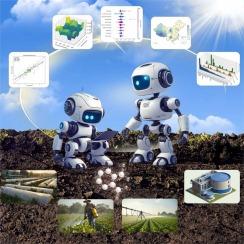算法与土壤之间的对话:机器学习揭开土壤中邻苯二甲酸盐污染之谜
IF 12.2
1区 环境科学与生态学
Q1 ENGINEERING, ENVIRONMENTAL
引用次数: 0
摘要
土壤是新出现的有机污染物邻苯二甲酸盐(PAEs)的主要环境汇,确定影响 PAEs 在土壤中积累的关键因素对于农业可持续发展和粮食安全至关重要。针对传统批量实验和统计预测模型在全面捕捉土壤中 PAEs 动态变化方面耗时长、效率低的特点,提出并开发了一种基于机器学习的智能分析框架。该研究纳入了 30 个特征,包括土壤 PAEs-浓度、污染物排放、农业投入、土壤理化性质和气候参数。建立了六个数据驱动的机器学习模型:随机森林回归(RFR)、梯度提升回归树(GBRT)、极端梯度提升(XGBoost)、多层感知器(MLP)、支持向量回归(SVR)和 k-近邻(KNN)。结果表明,MLP 模型在预测土壤 PAEs 浓度方面表现最佳(R²=0.8637),其次是 SVR(R²=0.8132)和 XGBoost(R²=0.8096)。通过特征重要性分析,确定水文气象因素、土壤水分条件和营养特征是控制 PAEs 空间分布的关键因素。此外,非线性效应分析还揭示了这些环境协变量之间显著的协同交互作用。时空预测模型显示,在未来 5-10 年内,东部沿海地区的 PAEs 污染水平将呈持续下降趋势,而内陆省份,尤其是贵州,则会出现累积趋势。该研究证明了机器学习在预测土壤PAEs污染方面的有效性和优势,为环境大数据时代的污染物风险评估和管理提供了新的视角。本文章由计算机程序翻译,如有差异,请以英文原文为准。

Dialogue between algorithms and soil: Machine learning unravels the mystery of phthalates pollution in soil
Soil is a major environmental sink for the emerging organic pollutants phthalates (PAEs), and the determination of key factors influencing PAEs accumulation in soil is crucial for agricultural sustainability and food security. Aiming at the time-consuming and inefficient characteristics of traditional batch experiments and statistical prediction models in comprehensively capturing PAEs dynamics in soil, an intelligent analysis framework based on machine learning was proposed and developed. In this study, thirty features were incorporated, including soil PAEs-concentrations, pollutant emissions, agricultural inputs, soil physicochemical properties, and climatic parameters. Six data-driven machine learning models were established: Random Forest Regression (RFR), Gradient Boosting Regression Tree (GBRT), Extreme Gradient Boosting (XGBoost), Multilayer Perceptron (MLP), Support Vector Regression (SVR), and k-Nearest Neighbors (KNN). Results showed that the MLP model exhibited optimal performance in predicting soil PAEs concentrations (R²=0.8637), followed by SVR (R²=0.8132) and XGBoost (R²=0.8096). Through feature importance analysis, it was determined that hydrometeorological factors, soil moisture conditions, and nutritional characteristics were the key factors controlling PAEs spatial distribution. Furthermore, non-linear effect analysis elucidated significant synergistic interactions among these environmental covariates. The spatiotemporal prediction model revealed continuous declining trends in PAEs pollution levels in eastern coastal regions over the next 5–10 years, while accumulation tendencies were observed in inland provinces particularly in Guizhou. This study demonstrates the effectiveness and advantages of machine learning in predicting soil PAEs-pollution, providing a new perspective for pollutant risk assessment and management in the era of environmental big data.
求助全文
通过发布文献求助,成功后即可免费获取论文全文。
去求助
来源期刊

Journal of Hazardous Materials
工程技术-工程:环境
CiteScore
25.40
自引率
5.90%
发文量
3059
审稿时长
58 days
期刊介绍:
The Journal of Hazardous Materials serves as a global platform for promoting cutting-edge research in the field of Environmental Science and Engineering. Our publication features a wide range of articles, including full-length research papers, review articles, and perspectives, with the aim of enhancing our understanding of the dangers and risks associated with various materials concerning public health and the environment. It is important to note that the term "environmental contaminants" refers specifically to substances that pose hazardous effects through contamination, while excluding those that do not have such impacts on the environment or human health. Moreover, we emphasize the distinction between wastes and hazardous materials in order to provide further clarity on the scope of the journal. We have a keen interest in exploring specific compounds and microbial agents that have adverse effects on the environment.
 求助内容:
求助内容: 应助结果提醒方式:
应助结果提醒方式:


